By 1973, the IRA had hatched a daring plan to hurt John Hume. In their eyes, he was a traitor to the cause – someone who was betraying the old ideals of nationalism and acquiescing in the partition of Ireland. The decision was taken to strike where he was most vulnerable – at his home.
John, Pat and their five children, Therese, Áine, Aidan, John and Mo, lived close to the Bogside in Derry. Everyone in the area knew the family home since it doubled up as a constituency office. Every day there would be a constant stream of people coming to the door looking for help or advice. Often, mothers and fathers would call seeking information on which police station their sons had been taken to after being arrested. To the Hume children, this was all normal. In those early days, the house had no security measures and Hume operated an open-door policy. Therese remembers that their home was rarely quiet; “People would come to the door the whole time. The house never emptied.”
In keeping with his beliefs of pacifism, Hume refused to carry a weapon for personal protection. His children played in the street and walked to school, often past walls daubed with graffiti insulting their father. The family home was regularly attacked with paint and stones and, understandably, Hume’s children often worried about their father’s safety.
Áine says she remembers praying to God that if her father was attacked, he would not suffer: “I remember bargaining a lot with God. Which is crazy, you know. Because I used to worry about Dad getting killed. So I remember saying, ‘Please can it be sudden, and please can it be that he does not have to suffer’. And trying to make it as untraumatic as possible, you know.”
RM Block
Áine may have worried and prayed about her father, but she too had become a target. She attended St Anne’s Primary School in the Rosemount area, was well-known as one of the Hume children, and walked home every day. Aware of who she was and the route she took, the IRA decided at one stage to kidnap her. On the day in question, the kidnappers arrived at the school and spotted their target as she left the premises. She was bundled quickly into a car and driven towards the Border. Her captors may have thought the operation had gone well until they realised they had snatched the wrong child. They had, in fact, picked up a girl who closely resembled Áine.
There would have been a lot of threatening letters, threatening phone calls, bullets sent in the post
— Therese Hume
It was a case of mistaken identity, and the girl was released unharmed, as Áine recalled: “They let her go once they looked at her schoolbooks. And I am just hugely grateful that it wasn’t me.”
What the IRA planned to do with Áine Hume had its members successfully kidnapped her is not clear. Was it an attempt to get her father to leave politics? What is clear is that the IRA had a deep loathing for Hume and his politics. Journalist Eamonn McCann recalls how he was viewed by them: “They hated him – that is not too strong a word to say. The people who would become the Provos – Provisional Sinn Féin or the Provisionals at the time – hated John Hume.”
[ A farewell to John Hume: ‘People in Derry felt robbed of a proper leavetaking’Opens in new window ]
McCann says the IRA were serious about hurting Hume: “I mean the Provos don’t like to be reminded of this. They attempted to kill John – they attempted to kill his family. There was one occasion they threw petrol bombs at John’s house in West End Park. The entire front of the house was engulfed in flames, the entire front of the house. It was a serious attempt to kill the Hume family.”
Hume was not just a target of republicans; he was also a hate figure to loyalist paramilitary groups. A well-known face through his many television appearances, he experienced abuse out in the streets. Aidan Hume remembers being out with his father when he was pelted with eggs, and another occasion when a dog was set on him. He also recalls being with his father in a van when they were surrounded by an angry mob: “There were probably about 15 people who attacked the van and tried to pull him out by the hair.”
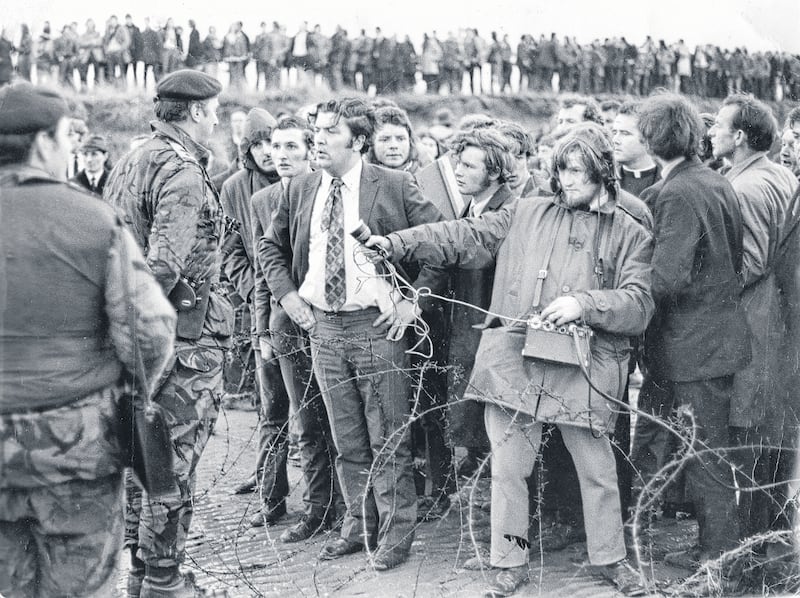
Politics was a dangerous world, and Hume’s children had to try to learn to deal with the consequences of being in the public eye. There would be demonstrations and protests outside the family home, fake bombs were left in the street, and there were abusive phone calls, as Therese Hume recalls: “There would have been a lot of threatening letters, threatening phone calls, bullets sent in the post one time, a couple of bullets sent at different times. That kind of thing was going on for quite a while and there was an undercurrent of nastiness.”
We basically were worried that we were being taken for a ride… We realised on the other hand that Gerry Adams probably wanted to move towards de-escalating the confrontation
— Alasdair McDonnell, SDLP
Áine says many families had similar experiences: “Everybody growing up in Northern Ireland developed a kind of antennae where you could walk into a room and almost before anybody said a word you could sense the level of hostility. It was just, I suppose, we had to learn in a way to kind of manage that.”
Mo Hume, John’s youngest daughter, says in later years she used to have to pass a wall on her way to school that bore the slogan “Hume Traitor”. She says that before the peace process, there was no cachet in being Hume’s daughter: “It was not cool. He was not cool. He was vilified, you know, so it wasn’t cool having John Hume as your dad.”
******
It was April 1993, and the then Sinn Féin leader Gerry Adams had been spotted going into Hume’s house in Derry by a neighbour who had passed this newsworthy piece of information on to Eamonn McCann. McCann in turn informed the reporter Ed Moloney, who rang Hume, and the story appeared the next day... Alasdair McDonnell [who would later become a leader of the SDLP] says activists had big concerns about what was happening: “I think everybody had misgivings. I mean, people were over a barrel in that they wanted the benefits, but they didn’t trust Adams to hold to his side of the bargain.”
McDonnell says there were genuine fears within the SDLP that Sinn Féin would use them politically: “We basically were worried that we were being taken for a ride… We realised on the other hand that Adams probably wanted to move towards de-escalating the confrontation. But we weren’t sure that he was not going to cannibalise the SDLP in the process, that he was not just going to use the SDLP as a platform.”
As Hume fielded calls from party members wanting to know what was going on, Adams was also trying to get in touch with the Foyle MP. Adams had been with Hume the day before but was now across the Border, some 14 miles from Derry on the Inishowen peninsula. The then Sinn Féin leader was staying with his cousin and had no mobile phone, so had to find a call box to make contact: “The only telephone access we had was in the Main Street in Buncrana and it was outside a pub, and there was I making these frenzied calls trying to get John and find out what was happening and doing whatever else I was doing. Until I realised, I had an audience of people with pints of Guinness and pints of beer all watching this going on.”
His appetite went. He was drinking outrageous amounts of coffee. He was smoking a lot of the time from what I can remember. And he was just very unhealthy
— John Hume on his father
The revelation that Hume and Adams were in discussions again provoked predictable responses. Unionists were furious and criticised the talks, arguing that he should not be in discussions while the IRA’s campaign continued. Despite the negative coverage, Hume was convinced that his meetings with Adams would bear fruit and was satisfied that eventually there would be a permanent ceasefire. With concern among party members about his discussions with Adams, Hume knew he had to say something. He attended several party meetings, and at one he offered to step away from politics if his initiative with Sinn Féin was not successful: “I said to the party meeting, ‘Look, my objective in this dialogue is to bring an end to the violence and if I fail, I will retire.’ I told that privately at a meeting, and they accepted that.”
******
The final draft of the Hume–Adams document was completed in June 1993. It was given secretly to the British and Irish governments with a view that it would be turned into an Anglo-Irish declaration. Hume did not immediately reveal that the document had been handed to officials because he wanted to give both governments an opportunity to digest it and work on it. The impression was created that the Hume–Adams discussions were continuing apace, and no one in London and Dublin went public with the fact that they had sight of a document, or that the substantive Hume–Adams talks were over.
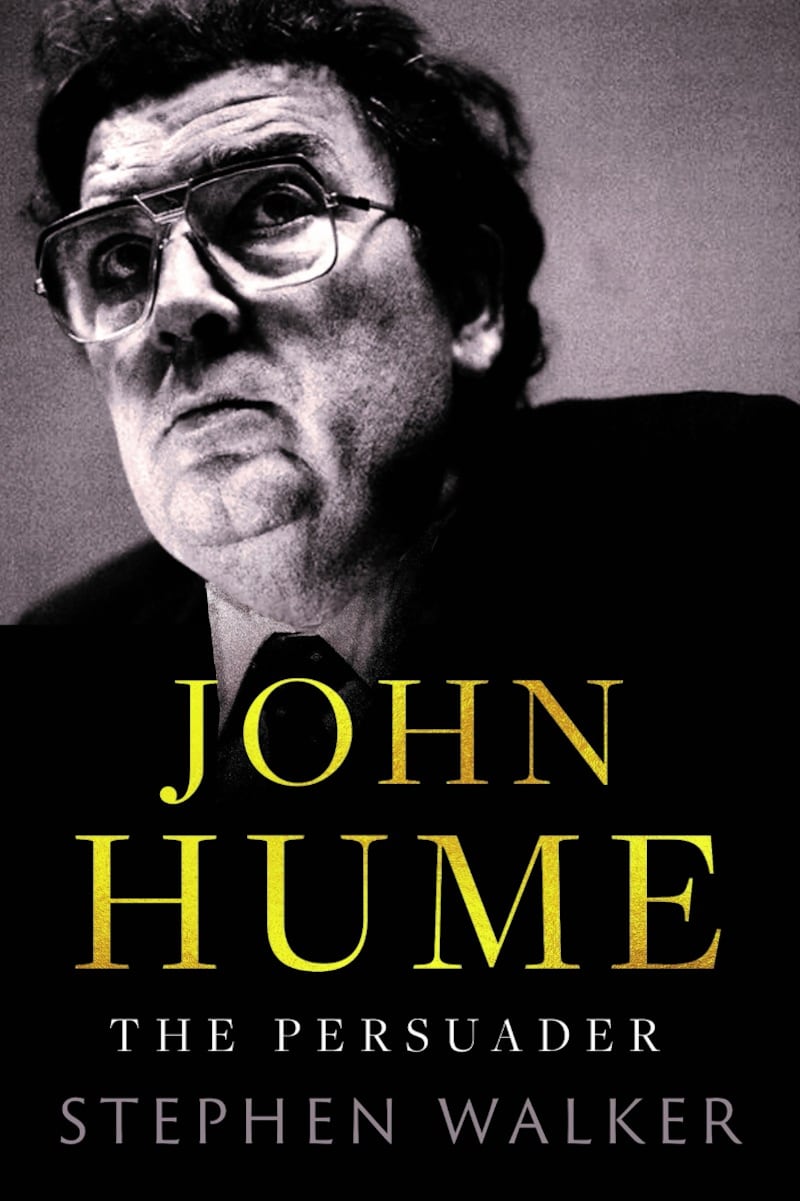
As the weeks went by, with no sign of movement from then British prime minister John Major or then taoiseach Albert Reynolds, Hume started to get anxious. As [later SDLP leader] Mark Durkan recalls: “John was getting frustrated. While you were getting these constant attacks, particularly coming from the Dublin media and all the rest of it, he was left wondering, ‘What is happening here? I have been hung out to dry here.’”
[ Funeral of John Hume hears peacemaker ‘gave dignity and life to so many people’Opens in new window ]
Hume felt isolated, and his family were worried about the pressure he was under. His son John remembers the time well: “You would have to have been blind to have not noticed the change in his physical appearance, which was a direct result of the pressure he was under. He stopped eating really. I mean, his appetite went. He was drinking outrageous amounts of coffee. He was smoking a lot of the time from what I can remember. And he was just very unhealthy, and a lot of that was driven by the pressure.”
******
October [1993] marked one of the most depressing and horrible months in the history of the Troubles. What followed were seven of the darkest days in the history of Northern Ireland. An IRA bomb went off without warning on Belfast’s Shankill Road, killing 10 people, including the bomber, Thomas Begley. Two children were among the dead and nearly 60 people were injured. The bomb was carried into Frizzell’s fish shop by Begley, who was dressed in a fishmonger’s white coat. He arrived at a time when the street was packed with Saturday afternoon shoppers.

The IRA would later say that its intended target was an office above the shops where it claimed UDA members were meeting. There was no one in the office at the time and the IRA killed shoppers and shop workers. After rescue workers spent hours at the scene clearing away the rubble, the full horror of the explosion became clear. Two of the dead were girls aged seven and 13 and another four were women. One woman lost both her parents in the explosion. The dead included the owner of the fish shop, Desmond Frizzell, and his daughter, Sharon McBride.
The images of people digging in the wreckage shocked the world and politicians from across the spectrum demanded answers from Adams and the republican movement. Why was this done? How was this justified? How was this part of a peace strategy? Adams said the attack was wrong and said the IRA, which had been planning to kill senior UDA figures, had been blinded to “the consequences of their actions if anything went wrong”.
The Hume family were shattered by the events on the Shankill Road and Hume himself came under intense pressure in the media to end his association with the then Sinn Féin president. Pat Hume recalled the hours that followed: “The phone started going, ‘John, the talks have to end. You can’t continue to give credibility to these people.’ And so the pressure mounted and mounted.”
Mark Durkan witnessed how upset Pat and John were: “I remember Pat in tears saying, ‘How do they say they are interested in peace when they are still doing things like that?’” The pressure on Hume and Adams intensified when the Sinn Féin leader carried the coffin of the bomber, Begley, at his funeral some days later. The image of the then Sinn Féin president shouldering the coffin made world headlines and the image became a defining moment. Adams knew how his appearance would be reported but felt he had to go to the funeral and had to show his respect to the Begley family. He later acknowledged why those families who lost relatives in the IRA would protest at his presence. Yet, Adams, as Sinn Féin president, knew he could not disown Begley, who was part of the republican movement. If he had not gone to the funeral, it would have probably ended his tenure as party leader.
[ Book on John Hume does not present him as saint, says sonOpens in new window ]
At his home in Derry, Hume watched the television footage of Adams carrying the coffin and started to cry. He was at breaking point both emotionally and physically. He had lost weight – since April, when his talks with Adams were revealed, he had shed two stone. Pat said it was a dreadful time for her husband: “He was not able to sleep. He was not eating properly. There were all sorts of vicious letters arriving in the post, vicious phone calls coming.”...
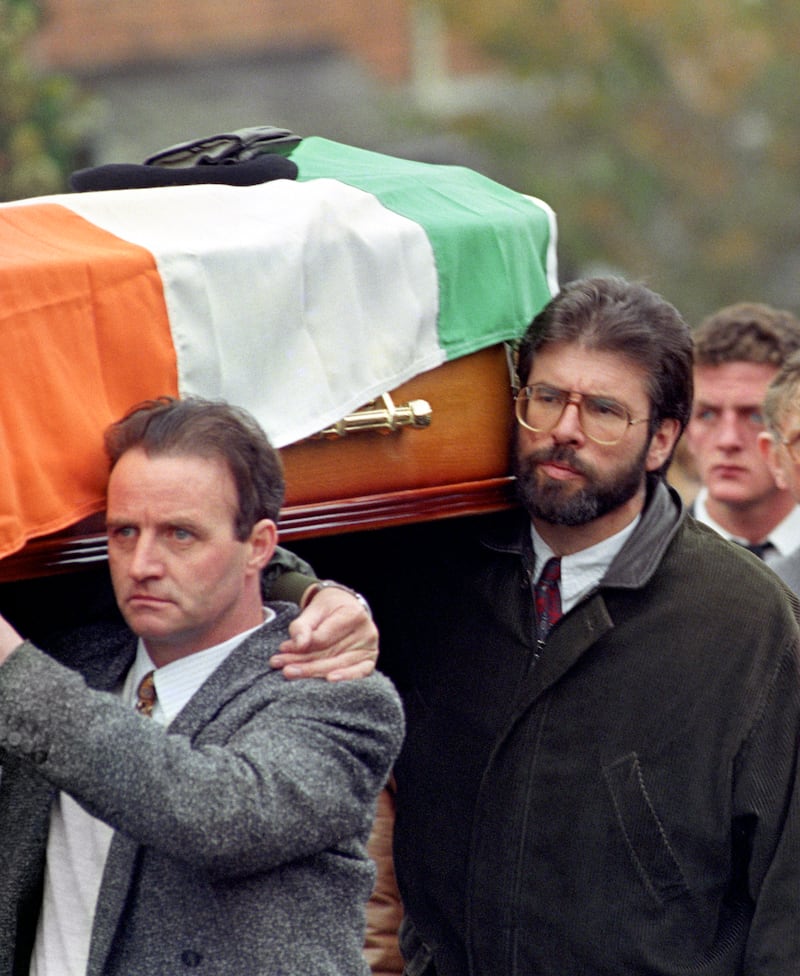
Like many times before, the Humes were in the line of fire. These were dark and frightening days in Northern Ireland, and a new generation of people were being traumatised by violence. As the funerals were being organised and the injured continued to be treated, the very thought of a political breakthrough seemed fanciful and far-fetched. This was the moment when Pat asked her husband to stop his discussions with Adams: “It was the first time that I said to John, ‘John, do you not think the talks have to end?’ And he was so intent on trying to get all violence to stop. I knew that he would continue.”
Pat was not the only family member who questioned the discussions with Adams. Áine said she considered what her father was doing, but concluded that he had to carry on with the discussions: “Everybody questioned that, you know. But he was right. I think it was a lonely road at times, but, you know, you just had to keep believing.”
Hume insisted to friends, family and journalists that he would carry on with his initiative with Adams. He told one interviewer that he would do “everything in my power to bring this to an end”. Sadly, the violence was far from over, and loyalist paramilitaries were now planning revenge. In the days that followed, six Catholic men were killed by the UVF and the UFF in random shootings in Belfast, Lurgan and Glengormley. SDLP members and elected representatives were on the loyalists’ hit list, and Hume was right at the top. The SDLP leader was considered by loyalists to be most vulnerable at his Donegal holiday home in Greencastle, close to the shores of Lough Foyle. This was where he relaxed and where he probably felt the safest. Hume did not carry a weapon as he believed in non-violence, and he did not want bodyguards.
However, such was the level of threat that eventually security measures were put in place. His son Aidan remembers what was done: “I think there was a concern about somebody coming over in a boat from the other side. So there was actually a caravan of gardaí in the garden. Typically, when he was in Donegal, he wouldn’t have had security, but I don’t think he had a choice.”
[ Tributes to John Hume flood in from Irish and international politiciansOpens in new window ]
A week after the Shankill bomb... UDA gunmen arrived at the Rising Sun bar [in the village of Greysteel, which is some nine miles to the east of Derry on the main A2 road], a popular spot which was busy, as it was a Saturday night and the evening before Halloween. As one of the gunmen walked in, he shouted “Trick or treat”, before opening fire with an automatic weapon. One woman, Karen Thompson, who was the youngest victim at 19, said “That’s not funny”. The bar was peppered with bullets and seven people were shot dead, and another man died later from his injuries. Adrian McAuley, who was a paramedic, was one of the first emergency responders at the scene: “We were stunned. We saw people shot and wounded and lying on the floor and slumped in their seats. The sound of crying and screaming was overwhelming.”
Part of the trouble you get into in the politics of Northern Ireland, for very obvious reasons, is you can never be quite sure what people are really saying to you
— Tony Blair
Northern Ireland was now experiencing its worst violence in decades. The Humes were in London that weekend, where John was speaking at a conference about the healing process, when news of the Greysteel massacre came through. That night the couple watched the television pictures from Northern Ireland with absolute horror. The next morning they went to Mass at a church in Kensington. Pat remembered that she found part of the service poignant: “I remember the gospel was the Sermon on the Mount. Blessed are those who tried to make peace. And I thought, maybe you should continue.”

******
In an interview for this book, Tony Blair [who became British prime minister in 1997] recalls his first impressions of the SDLP leader:
“John had this habit. He would, if you were in the division lobby, he would sidle up to you in a very conspiratorial way, then he would just say, ‘Can I have a quick word with you?’ And, to be honest, it wasn’t often a quick word, but he would explain the situation and he would explain the pressures that were on him, pressures from within his own party. A lot of people within his own party were actually quite irritated with what he was doing. In fact, angry about what he was doing, because they thought it was validating Sinn Féin without forcing them to change. So that again is where his own… the bigness of this character was very important. I mean, I never thought of him as an SDLP figure. I thought of him as John Hume, you know, as I say, he was a figure in his own right.”
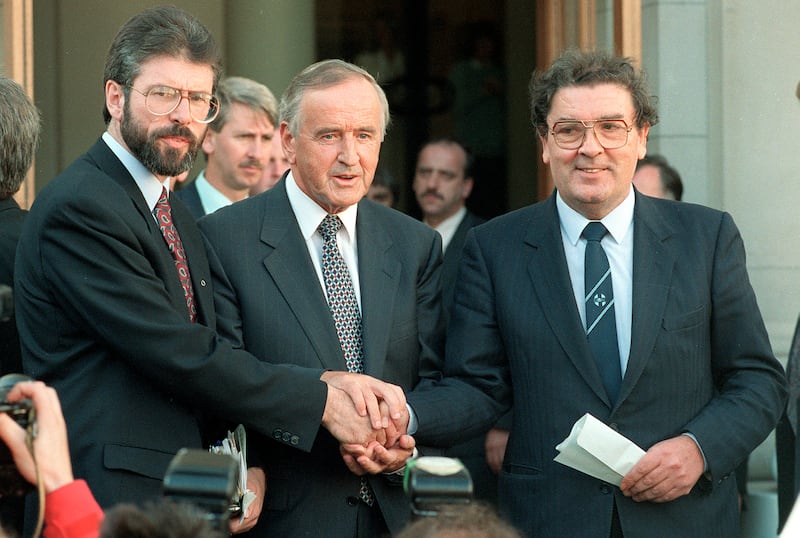
******
Blair appointed Mo Mowlam, the MP for Redcar, as shadow Northern Ireland secretary [in 1994]. She had similar views to Blair and had helped to organise his Labour leadership bid... Mowlam’s appointment raised some eyebrows in the conservative male-dominated world of Northern Ireland politics. She was a blunt, plain speaker who was personable, fun and engaging, and did not stand on ceremony. She was seen by some commentators as a “breath of fresh air” who threw herself into the new job. Like Blair, she made it clear she would not act as a persuader for a united Ireland, but wanted a political settlement that all sides could support. Hume knew Mowlam well and got on with her. He was well used to her larger-than-life personality, her quirky sense of humour and her regular use of salty language... Durkan remembers how she would often refer to Hume during meetings: “If John was going into tutorial mode with her, she would go, ‘Yes, Daddy, Yes Daddy, I understand that Daddy.’ And at times she would call him ‘s**tface’. This was not just to focus attention, but also the attention of the room. She would also call [then deputy SDLP leader] Seamus Mallon ‘sh**face’ occasionally as well.”
[ Gerry Adams at 75: What role now for Sinn Féin’s former president?Opens in new window ]
Hume’s relationship with Mowlam and Blair would prove to be crucial in the months after the ceasefire...
******
The arrival of Blair in Downing Street [in 1997] changed the political dynamic and there was a feeling that the peace process might just be given a new lease of life. Mowlam landed in Belfast as the new Northern Ireland secretary declaring that a fresh ceasefire was her priority. She and Hume quickly developed a good rapport, as Aidan Hume recalled: “Mo Mowlam would be someone Dad had an enormous respect for. He saw her as one who had a lot of personal courage.” As promised, talks began again in June, but once more Sinn Féin was absent from the discussions. Blair made it clear how republicans could enter the talks process, and made it clear that there had to be a fresh IRA ceasefire that was lasting and permanent. In July Hume and Adams met, and after their discussions the two men issued a joint statement. It was quite an upbeat assessment which praised the new British government and the new Irish administration headed by Fianna Fáil’s Bertie Ahern. The new taoiseach had taken office just weeks after Blair had come to power in the UK.
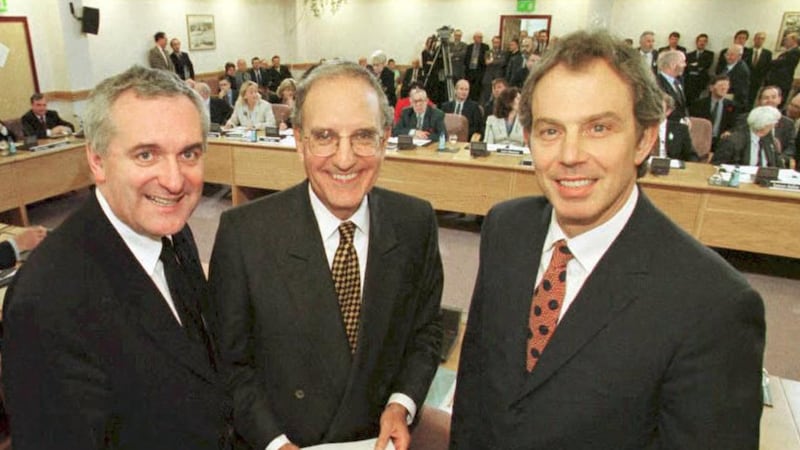
Blair says Hume had the ability to outline in precise terms exactly what was happening. In an interview for this book, Blair said Hume spoke clearly with authority: “He was an incredibly useful explainer of what was really going on. Because part of the trouble you get into in the politics of Northern Ireland, for very obvious reasons, is you can never be quite sure what people are really saying to you. And it is very difficult if you are an outsider, and you know you are an outsider – even if you are British prime minister you are still an outsider, in one sense. And it’s very hard at times to comprehend whether what people are telling you is what they are really telling you.”
John Hume The Persuader, by Stephen Walker, is published by Gill Books on October 12th















